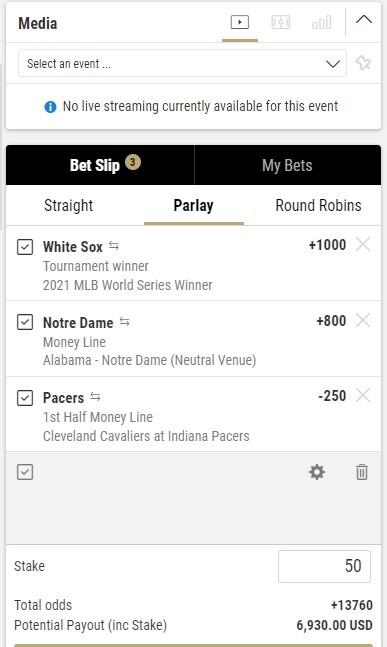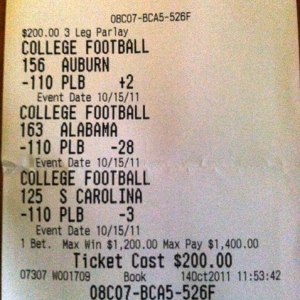
A wager and its winnings from a previously successful bet used for additional betting. A type of bet, usually wagered on pro team sports, where all teams picked must all win in order to collect a fixed wager. V.- to bet in such a manner (or just gambling in general) Typical Parlay Payouts. Gambling has been a popular activity in the United States for centuries. It has also been suppressed by law in many areas for almost as long. By the early 20th century, gambling was almost uniformly outlawed throughout the U.S. And thus became a largely illegal activity, helping to spur the growth of the mafia and other criminal organizations.
Everyone makes moneyline bets without even knowing it. Even non-gamblers make moneyline bets. Betting the moneyline for a game is possibly the most simple way to wager on sports. Bettors just choose a player or team to win. If the bettor chooses the winning side, the sportsbook will pay the amount due. It’s really that simple.
There’s no point spread with a moneyline bet. Bettors are just picking the winning side. While placing a wager is simple, trying to understand how the moneyline pays might be a bit complicated. Both sides of each moneyline wager are paid on a different schedule and that could make this kind of bet confusing.
The favorite team or player on the moneyline is the team that’s expected to win. This side of the bet usually listed with a minus (-) sign. The underdog team or player on the moneyline is the team that’s expected to lose. This side of the moneyline is usually listed with a plus (+) sign. These signs signify how either side of the wager will pay. The minus side will pay less than original wager while the plus side will pay more than the original wager.
BETMGM SPECIAL - New Customers receive a Risk Free First Bet up to $600 + $50 Parlay Insurance for the Big Game! (Just opt-in and place a One Game Parlay wager with 4 legs or more on The Big Game and if you miss one leg, you’ll receive up to $50 back in Free bets. (Maximum 20 legs) - To Claim Click This Link
Example of a moneyline wager
Low scoring sports like baseball, soccer, and hockey are usually bet on using a moneyline. But they are also popular in football. The best way to explain how moneyline bets are paid is with an actual example. Let’s use the upcoming Super Bowl between the Kansas City Chiefs and Tampa Bay Buccaneers as an example.
The easiest way to understand moneyline wagers is by using a $100 bet. Using the above example, the moneyline on the underdog Buccaneers opened at +148 (currently ). At +148 odds, a $100 wager would pay $148 in profit if the Buccaneers won the game (for a total payout of $248). Bettors often like picking underdogs because they are usually “plus” money. This side of the moneyline bet pays out more money per unit than a wager on the favorite.
In this example, the moneyline on the favorite Chiefs opened at -176 (currently ). At -176 odds, a bettor would need to wager $176 to win $100. Since the favorite is considered the team with the better chance to win, a winning wager will usually pay out less than the original amount wagered.
Looking deeper into moneyline wagers

The two sides of each moneyline wager are essentially the opposite of each other. When wagering on the favorite it’s easiest to work from the dollar amount that will return a win of $100. When wagering on an underdog it’s easiest to understand how the moneyline pays based on how much a $100 wager will pay.
Understanding how a moneyline wager pays isn’t simple but it’s not very complicated. That said, it might take running through a few examples before fully grasping the payouts. Moneylines for football and basketball games are often tied to the point spread. When a game has a large point spread it usually has a large moneyline. Both are separate bets but are shown together in a sports wagering app screen and in a brick and mortar sportsbook.

As seen above, lines and odds may be different at various sportsbooks so consider this just an example of point spread line and a moneyline.
ALSO READ: 5 Fun Super Bowl prop bets to consider
Moneyline parlays
Moneyline parlays are growing in popularity. A parlay is a single wager that is comprised of multiple results. The payout for a parlay is greater than an individual wager on each player or game. Underdog moneyline parlays are becoming popular because the payouts can be very large. Moneyline parlays are becoming popular because of the perceived ease of choosing multiple favorites to win. Choosing one winner is difficult and multiple winners at the same time is even more difficult.

A parlay, accumulator (or acca), combo bet or multi is a single bet that links together two or more individual wagers and is dependent on all of those wagers winning together. The benefit of the parlay is that there are much higher payoffs than placing each individual bet separately, since the difficulty of hitting all of them is much higher. If any of the bets in the parlay lose, the entire parlay loses. If any of the plays in the parlay ties, or 'pushes', the parlay reverts to a lower number of teams with the odds reducing accordingly.
Parlay Bet Definition Synonyms
Odds and payout[edit]
Parlay bets are paid out at odds higher than the typical single game bet, but still below the 'true' odds. For instance, a common 2-team NFL parlay based entirely on the spread generally has a payout of 2.6:1.[citation needed] In reality however, if one assumes that each single game bet is 50/50, the true payout should instead be 3:1 (10% expected value for the house). A house may average 20-30% profit on spread parlays compared to perhaps 4.5% profit on individual sports mix parlay bets.
Aside from 'spread' parlays, another way to parlay is to bet on two or more teams simply winning straight up. In order to calculate the payout of this parlay, one must multiply out the payout for all games. For example, if 3 teams are -385 favorites, a successful parlay on all 3 teams winning would pay out at a ratio of approximately 1/1. This is because (385/485)^3 is approximately 50%.
Examples[edit]
Typical payouts for up to 10 team parlay bet[edit]

The following is an example of a traditional Las Vegas Parlay Card at William Hill Sports Book, which shows the typical payouts for an up to 10 team parlay bet based on -1.10 prices (amount won is assuming $100 is bet)[citation needed]:
Round Robin Bet
| Number | Odds | Amount won | Payout |
|---|---|---|---|
| 2 Team Parlay | 2.6 to 1 | $260 | $360 |
| 3 Team Parlay | 6 to 1 | $600 | $700 |
| 4 Team Parlay | 11 to 1 | $1,100 | $1,200 |
| 5 Team Parlay | 22 to 1 | $2,200 | $2,300 |
| 6 Team Parlay | 45 to 1 | $4,500 | $4,600 |
| 7 Team Parlay | 90 to 1 | $9,000 | $9,100 |
| 8 Team Parlay | 180 to 1 | $18,000 | $18,100 |
| 9 Team Parlay | 360 to 1 | $36,000 | $36,100 |
| 10 Team Parlay | 720 to 1 | $72,000 | $72,100 |
Profitability of parlays in sports betting[edit]
Many gamblers have mixed feelings as to whether or not parlays are a wise play. The best way to analyze if they are profitable in the long term is by calculating the expected value. The formula for expected value is: E[X] = x1p1 + x2p2 + x3p3…xkpk . Since the probability of all possible events will add up to 1 this can also be looked at as the weighted average of the event. The table below represents odds.[citation needed]

Column 1 = number of individual bets in the parlay
Column 2 = correct odds of winning with 50% chance of winning each individual bet
Column 3 = odds payout of parlay at the sportsbook
Column 4 = correct odds of winning parlay with 55% chance of winning each individual bet
| Number of individual bets | Correct odds at 50% | Odds payout at sportsbook | Correct odds of winning parlay at 55% |
|---|---|---|---|
| 2 | 3 to 1 | 2.6 to 1 | 2.3 to 1 |
| 3 | 7 to 1 | 6 to 1 | 5.0 to 1 |
| 4 | 15 to 1 | 12 to 1 | 9.9 to 1 |
| 5 | 31 to 1 | 24 to 1 | 18.9 to 1 |
| 6 | 63 to 1 | 48 to 1 | 35.1 to 1 |
| 7 | 127 to 1 | 92 to 1 | 64.7 to 1 |
| 8 | 255 to 1 | 176 to 1 | 118.4 to 1 |
| 9 | 511 to 1 | 337 to 1 | 216.1 to 1 |
| 10 | 1,023 to 1 | 645 to 1 | 393.8 to 1 |
| 11 | 2,047 to 1 | 1,233 to 1 | 716.8 to 1 |
The table illustrates that if a 55% chance of winning each individual bet were achievable, parlays would be profitable in the long term. Compare the expected value you receive on an individual bet at a typical price of -110 with a 55% chance of winning: ((100/110+1)*.55)-1 = .05 (exactly 5 cents won for every dollar bet on average), multiplied by 11 = .55, to the expected return on the 11 game parlay ((1234/717.8)-1) = .719 (72 cents won for every dollar bet on average). In this case a parlay has a much higher expected value than individual bets with greatly increased variance in outcomes.
See also[edit]
